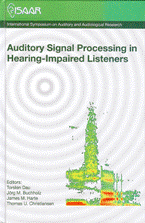Interactive fitting of hearing aids
Abstract
This paper describes a pilot experiment with an experimental procedure for individualized ne-tuning of hearing-aid fittings. The preference of a hearing- aid user is determined by a comparison between different sound samples. This preference is fed to a mathematical optimization system (a modified simplex procedure) that ef ciently chooses the next comparison. The system should eventually converge to the optimal hearing-aid setting. In order to improve the input of the optimization algorithm, a two-step paradigm was developed. The listeners were presented with three sound samples. First, they had to determine which sample differed from the other two (three-alternative forced choice with an ‘odd-ball paradigm’). This step was included to increase the reliability of the second step in which the listeners had to judge which of the different samples sounded better (two-alternative unforced choice). The new paradigm was tested with speech in noise (SNR=+5 dB) for three parameters of a simulated four-channel compression hearing aid. The results indicate that the new paradigm was much less time-consuming that those previously described in literature. However, for both normal hearing and hearing-impaired subjects, the minimally perceived differences between hearing-aid settings were large compared to the values relevant for clinical practice. This indicates that either the subjects did not hear the differences between the samples or that the task was too dif cult. Based on user comments, it is likely that the unfavourable results were largely caused by the odd-ball paradigm. A slight adaptation of the procedure might lead to better results in the future.
References
Dirks, D. D., Ahlstrom, and J., Noffsinger, D. (1993). “Preferred frequency response for two- and three-channel ampli cation systems, J. of Rehabilitation Research and Development,” 30, 305–317.
Franck, B. A. M., Dreschler, W. A., and Lyzenga, J. (2004). “Methodological aspects of an adaptive multidirectional pattern search to optimize speech perception using three hearing-aid algorithms,” J. Acous. Soc. Am. 116(6), 3620–3628.
Franck, B. A., Boymans, M., Dreschler, W. A. (2007). “Interactive fitting of multiple algorithms implemented in the same digital hearing aid,” Intern. J. of Audiol. 46, 388–397.
Houben, R. (2006). “The effect of amplitude compression on the perception of speech in noise by the hearing impaired,“ thesis Universiteit Utrecht, The Netherlands
Kuk, F. K., and Pape, N. M. C. (1992). “The reliability of a modi ed simplex procedure in hearing aid frequency-response selection,” J. of Speech and Hearing Research. 35, 418–429.
Levitt, H., Neuman, A. C., Mills, R., Schwander, T. (1986). “A digital master hearing aid,” J. of Rehabilitation Research and Development. 23, 79–87.
Lijzenga, J. (1997). “Discrimination of simplified vowel spectra,” thesis Rijksuniversiteit Groningen, The Netherlands.
Neuman, A. C., Bakke, M. H., Mackersie, C., Hellman, S., and Levitt, H. (1998). “The effect of compression ratio and release time on the categorical rating of sound quality,” J. Acous. Soc. Am. 103, 2273-2281.
Preminger, J. E., Neuman, A. C., Bakke, M. H., Walters, D., Levitt, H. (2000). “An examination of the practicality of the simplex procedure,” Ear and Hearing, 21, 177–193.
The Mathworks, Inc. (2005). “Matlab, R14,” Natick, MA, USA
Versfeld, N. J., Daalder, L., Festen, J. M., and Houtgast, T. (2000). “Method for the selection of sentence materials for efficient measurement of the speech reception threshold,” J. Acous. Soc. Am. 107, 1671–1684.
Additional Files
Published
How to Cite
Issue
Section
License
Authors who publish with this journal agree to the following terms:
a. Authors retain copyright* and grant the journal right of first publication with the work simultaneously licensed under a Creative Commons Attribution License that allows others to share the work with an acknowledgement of the work's authorship and initial publication in this journal.
b. Authors are able to enter into separate, additional contractual arrangements for the non-exclusive distribution of the journal's published version of the work (e.g., post it to an institutional repository or publish it in a book), with an acknowledgement of its initial publication in this journal.
c. Authors are permitted and encouraged to post their work online (e.g., in institutional repositories or on their website) prior to and during the submission process, as it can lead to productive exchanges, as well as earlier and greater citation of published work (See The Effect of Open Access).
*From the 2017 issue onward. The Danavox Jubilee Foundation owns the copyright of all articles published in the 1969-2015 issues. However, authors are still allowed to share the work with an acknowledgement of the work's authorship and initial publication in this journal.


